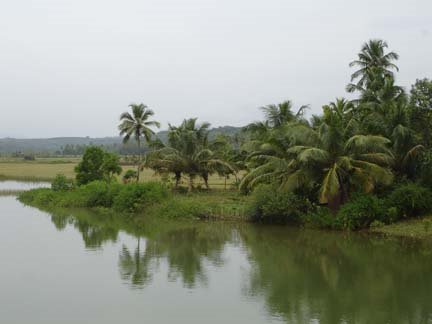It is obvious that many of the ancient words
have travelled to different parts of the world along with human migrants and
eventually evolved further in multitudes of patterns during the course of the
history. The previous two posts on aspects of dispersion and evolution of basic
words in Indo-European group of languages provide clues to the inference.
There may be several more examples, so far not
reported or not recognized words, apparently unconnected and spatially
disconnected, though in reality, might happen to be analogous scattered words, spread
in different parts of the world.
Recently, while walking along the urban
streets of Zurich, Switzerland, as a tourist, I chanced to notice a German word
on the signboards which bore resemblance to a familiar Kannada word. (In
Switzerland, a Swiss variety of German
is the common language in usage). The word that drew my attention was “halle” which bears resemblance to
Kannada word “halli”, somewhat also
in pronunciation.
The current meaning of the German word “halle”(pronounced as hall or halli in German) as is found in central parts of Europe including
Switzerland is, a hall, a lobby, a hangar, a foyer or a vestibule. You can find
commercial establishments like recreation halls, auditoria, restaurants and
bars variously named as Halle 622,
Saalsporthalle, Tonhalle, Kronehalle, etc. in Zurich or other parts of Switzerland.
However, you can find also a town
(formerly a village) known as Halle in Saxony, Germany which suggests that the word was also a traditional place name in the
past.
 |
| A rural scenario along Zurich to Milan road, Europe |
Halli in Kannada
The “halli” in Kannada stands for village.
The related Kannada word “halla” means a lake, therefore a habitation developed
by the side of a halla came to be
known as a halli or village. However, genetically the word hall evolved in
medieval Kannada from an older version of the word namely “palli”. Thus the halli
in Kannada is the result of pa > ha transition that was adopted probably
around 10th century CE or later.
In Tulu language, the pa>ha literary transitions adopted in medieval Kannada has not
made its presence felt, probably due to lack of proper literary works in
medieval Tulu. Hence, we do not find any incidence of halli place names in Tulu. However in northern part of Tulunadu,
around and north of Barakur, the provincial coastal capital of Vijayanagar
rulers, we find village names ending with suffix of halli such as Kukkehalli, Molahalli etc.
However, we can also find some “halli”
village names in present day Telugu and Tamil regions probably named during the
past history, under the influence of neighboring Kannada people. For example:
Muttanahalli, Mukkalnaikanahalli, Molappanahalli etc in Tamilnadu and
Baginaikanhalli, Chelimenhalli, Natchahalli etc in Telangana/Andhra Pradesh.
Palli in
Dravidian langauges
The ancient word palli for village, exists
in most of Dravidian languages including Tulu.(For example: Tiruchirapalli, Moranapalli - Tamil; Chintapalli -Telugu, Palli, Bellampalli- Tulu etc). The word palla means a lake , hence a habitation
by the side of palla came to be known
as a palli. However, during the
course of history, in Tulunadu, the word palli
was adopted by local Beary Muslims to represent mosques. Probably as result,
the usage of the word palli for
village was restricted thereafter. Conversely, we can presume that palli place names in Tulunadu are older
in age and were named before the advent of Beary community and their adoption
of the word palli for mosques.
Palle in
Telugu
The palle
(instead of palli) is one of the
common habitation suffixes found in Telugu language regions. It is interesting
to note that the Telugu village name lists sport abundant number
of –palle suffixes. A few examples of Telugu village names:
Anakapale, Bandepale, Kothapalle,
Thippepalle, Vangapalle etc.
Palli in
Munda/Prakrit
The ancient habitation suffix palli (or its modified version pali ) also exists in Munda and Prakrit
language regions of India. W can find adequate village names having palli as suffix or as stand-alone
village names distributed in the north
Indian States of Chhattisgarh, Bihar,
Gujarat etc.
Palli in
Sanskrit
The
word palli as such also exists in
Sanskrit. Thus, the presence of halli/palli in Dravidian and Indo-European
Sanskrit suggests that the original root word could be ancient one, that was also shared by European languages
during the past history.
Palle in Italy: Tripalle
It was curious to know whether
the pa > ha transition has taken place in Europe also. Casual search in the
web suggested the place name of Tripalle, a village in Italy. (There could be
many such –palle words: it needs
detailed search).
Other Euro African examples
Other Euro African examples
'Tripoli', Libyan capital city can
be added to the list of relevant examples. It was founded by Greek
Phoenicians in 7 C. BC, came under the rule of Carthaginians, Romans,
Italians and lastly Turkey Ottomans.
In Basque, an analogous spatial term “hel-bide” means an address. In
Hungarian, the word “helly” carries meanings
such as: a place, location, address or town. Besides the term 'falu means a village.
Inferences
The essence of this post is preliminary
exploration and reporting of the possibility that the original habitation/village indicator words palle
(palli) > halle (halli) might have been an ancient root word adopted
by ancestors of Indo-European and Dravidian communities that eventually
dispersed in different regions of the globe during the past history. At this
point of time it is difficult to trace the place of origin of this place name
(as it would demand further detailed studies).
Similarly, the p>h or pa> ha
transition in German and Kannada languages may not be mere coincidence. Whether
this transition was an influence of Europe on Kannada or vice versa would be a
matter of further detailed linguistic and socio-environmental analysis.
R





